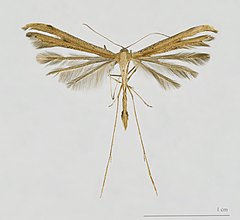Plume moth
| Plume moths | |
|---|---|
 |
|
|
Emmelina monodactyla (Pterophorinae: Pterophorini) |
|
| Scientific classification | |
| Kingdom: | Animalia |
| Phylum: | Arthropoda |
| Class: | Insecta |
| Order: | Lepidoptera |
| Suborder: | Glossata |
| Infraorder: |
Heteroneura
|
| Superfamily: | Pterophoroidea |
| Family: |
Pterophoridae Zeller, 1841 |
| Type species | |
|
Pterophorus pentadactyla Linnaeus, 1758 |
|
| Subfamilies | |
|
Agdistinae |
|
| Diversity | |
| >90 genera >1,000 species |
|
Clade: Ditrysia
Clade: Apoditrysia
Agdistinae
Deuterocopinae
Macropiratinae (sometimes given family status as Macropiratidae)
Ochyroticinae
Pterophorinae
The Pterophoridae or plume moths are a family of Lepidoptera with unusually modified wings. Though they belong to the Apoditrysia like the larger moths and the butterflies, unlike these they are tiny and were formerly included among the assemblage called "Microlepidoptera".
The forewings of plume moths usually consist of two curved spars with more or less bedraggled bristles trailing behind. This resembles the closely related Alucitidae (many-plumed moths) at first glance, but the latter have a greater number of symmetrical plumes. The hindwings are similarly constructed, but have three spars. A few genera have normal lepidopteran wings.
The usual resting posture is with the wings extended laterally and narrowly rolled up. Often they resemble a piece of dried grass, and may pass unnoticed by potential predators even when resting in exposed situations in daylight. Some species have larvae which are stem- or root-borers while others are leaf-browsers.
Economically important pterophorids include the artichoke plume moth (Platyptilia carduidactyla), an artichoke (Cynara cardunculus) pest in California, while the geranium plume moth (Platyptilia pica) and the snapdragon plume moth (Stenoptilodes antirrhina) can cause damage to the ornamental plants garden geranium (Pelargonium x hortorum) and common snapdragon (Antirrhinum majus), respectively. Other plume moths have been used as biological control agents against invasive plant species – Lantanophaga pusillidactyla against West Indian lantana (Lantana camara), Oidaematophorus beneficus against mistflower (Ageratina riparia), Hellinsia balanotes against groundsel bush (Baccharis halimifolia), and Wheeleria spilodactylus against horehound (Marrubium vulgare).
...
Wikipedia
